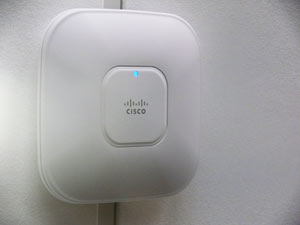The University of Mississippi (UM) wireless network began in 2007 and, over time, has expanded to include more than 70 buildings. The wireless network is managed by the Office of Information Technology (IT) and currently consists of 822 wireless access points, a number that grows daily. The most recent additions came this past fall when wireless access was made available in Bondurant Hall, Bishop Hall, and Hume Hall. There are 56 wireless access points in Campus Walk, the highest number for any UM residential area. To find out about current wireless availability, visit Wireless Service Support.
Keeping up with Ever Increasing Bandwidth Needs
Provisioning and administering bandwidth is an ongoing challenge for most major universities. IT works diligently to provide a network that is open, flexible, and secure and promotes an optimal learning environment. This involves giving priority to network traffic that is closely tied to UM’s academic mission such as access to Blackboard and myOleMiss, research projects, and administrative activities. This past fall, IT acquired more commodity Internet bandwidth to accommodate increased network usage and also adjusted network management policies to give more bandwidth to residence halls after 6 p.m. when many UM offices are closed. IT also added fair share policies that prevent a single person from taking all of the available bandwidth. IT evaluates bandwidth requirements regularly to determine if more resources are needed to accommodate growing demand. Plans are already underway to acquire more overall bandwidth for August 2011.
Figure 1 shows Oxford campus bandwidth usage during the last year. Blue represents outgoing traffic, and green represents incoming. Note the increases and decreases that follow the academic calendar. That is, when students are not on campus, bandwidth usage plunges. Also, note the overall increase over time.
A related issue, which is also an ongoing challenge for most major universities, is curbing illegal downloads and copyright infringement on the campus network, especially in residence halls. IT receives several reports each week from groups such as the Recording Industry Association of America (RIAA) of network users illegally downloading movies or music. In these cases, the offender is blocked from the campus network, and disciplinary actions are initiated. See https://umnoc.olemiss.edu/blocked for a list of currently blocked addresses. With the increase in legitimate media streaming services, it is becoming more and more difficult to discern in an automated way which activities are illegal and which are not. This sometimes leads to network policies that inadvertently throttle legitimate traffic. Good communication between IT and users of the network is crucial in order to prevent legitimate streaming services from being throttled or blocked.
Network Access Control (NAC) = Safe Network
In September 2009, IT implemented Cisco Systems’ Network Access Control (NAC) Agent as a security measure, allowing the network to identify the user and grant access. NAC systems are used broadly in university and corporate settings as a means for maintaining a clean network. Users of the UM wireless network are required to install a small application called the NAC Agent on their computers when they first connect. Once installed, the software (Cisco Clean Access Agent) will enable these computers to automatically logon and remain online throughout the day. The NAC Agent also allows for the connecting system to be checked, for example to ensure anti-virus software and operating system patches are up to date.
IT Helpdesk call logs suggest that most issues reported with the wireless network are actually problems installing the NAC client on a particular laptop. For example, the NAC Agent will not install correctly if the computer is infected with a virus or has a firewall that is not configured correctly. For a full list of potential NAC issues, see https://wireless.olemiss.edu/nac.html.
Although the use of NAC technology is critical for network security, it can cause problems for gaming devices. Browser-less consoles (e.g., Wii) which have wireless-only capability are not supported, because they can’t authenticate the WebID and password. These devices boot up and try to connect to the wireless network, but will not be successful. Gaming consoles with an Ethernet port (e.g., Xbox 360 and PlayStation 3) can connect via Ethernet cable to the wired network without WebID authentication. IT is currently working with vendors to incorporate support for browser-less devices and plans to “go live” with this functionality in August 2011.
Contact Us
Since January 2011, fewer than fifty trouble tickets have been logged regarding the wireless network, yet in this same time frame over 90,000 devices were logged in. If you are experiencing any technical difficulties, please contact the IT Helpdesk at 662- 915-5222 or helpdesk@olemiss.edu so that issues can be addressed and resolved. This includes reports of a slow network. In these cases, it is very important to note the time and location of the access as well as the kind of service that was being used such as Facebook or Blackboard. We appreciate your help as we continue to work to provide a high quality network experience for everyone.
Tags: Network, Wireless
